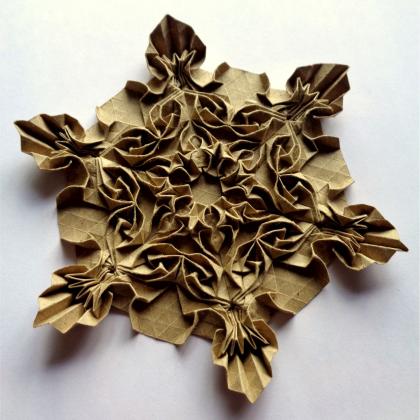The Panagbenga Medallion, like other origami medallions, is a result of a study for designing larger origami tessellations, yet it can look nice as a standalone ornament.
Origami medallions are usually designed with complex modifications of the basic techniques in folding origami tessellations and are mainly characterized by their aesthetic three-dimensional details. Oftentimes, adding too many pleats and twists causes some medallion designs to inappropriately require grids as large as those required by standard tessellations. Moreover, with the use of large grids, these medallions would consequently have constraints in their crease patterns, which further leads to some parts of the paper not being fully utilized and would end up being plain and flat rather than having 3-D details. Unlike the design of these medallions, the Panagbenga Medallion makes it possible to efficiently fit more intricate 3-D elements within the boundaries of a relatively smaller grid by simplifying and combining common, sophisticated, and unique techniques in origami tessellations in conjunction with those of other types of origami such as corrugations and hex pleating. With that being said, the design of the Panagbenga Medallion has made a technical breakthrough in the field of abstract origami.
See the attached file to learn more about the artistic and technical aspects of the Panagbenga Medallion.
Origami medallions are usually designed with complex modifications of the basic techniques in folding origami tessellations and are mainly characterized by their aesthetic three-dimensional details. Oftentimes, adding too many pleats and twists causes some medallion designs to inappropriately require grids as large as those required by standard tessellations. Moreover, with the use of large grids, these medallions would consequently have constraints in their crease patterns, which further leads to some parts of the paper not being fully utilized and would end up being plain and flat rather than having 3-D details. Unlike the design of these medallions, the Panagbenga Medallion makes it possible to efficiently fit more intricate 3-D elements within the boundaries of a relatively smaller grid by simplifying and combining common, sophisticated, and unique techniques in origami tessellations in conjunction with those of other types of origami such as corrugations and hex pleating. With that being said, the design of the Panagbenga Medallion has made a technical breakthrough in the field of abstract origami.
See the attached file to learn more about the artistic and technical aspects of the Panagbenga Medallion.
Creator:
Malvin Roix M. Orense
Category:
Abstract
Type:
Technical
Creation Date:
